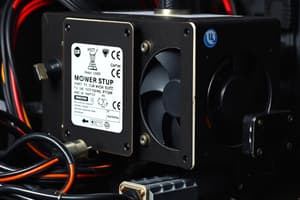Podcast
Questions and Answers
What is the primary function of the transformer in a power supply unit?
What is the primary function of the transformer in a power supply unit?
- To filter and smooth output voltage
- To step down AC voltage from the wall outlet (correct)
- To regulate output voltage
- To convert DC voltage to AC voltage
What is the purpose of the voltage regulator module (VRM) in a power supply?
What is the purpose of the voltage regulator module (VRM) in a power supply?
- To filter and smooth output voltage
- To step down AC voltage from the wall outlet
- To regulate output voltage (correct)
- To convert AC voltage to DC voltage
What is the primary function of the capacitors in a power supply unit?
What is the primary function of the capacitors in a power supply unit?
- To convert AC voltage to DC voltage
- To step down AC voltage from the wall outlet
- To filter and smooth output voltage (correct)
- To regulate output voltage
What is the purpose of the fan in a power supply unit?
What is the purpose of the fan in a power supply unit?
What does the wattage rating of a power supply unit indicate?
What does the wattage rating of a power supply unit indicate?
What does the 80 PLUS certification indicate?
What does the 80 PLUS certification indicate?
What is the primary difference between a modular and a non-modular power supply unit?
What is the primary difference between a modular and a non-modular power supply unit?
Study Notes
Power Supply
Functions:
- Converts Alternating Current (AC) power from the wall outlet to Direct Current (DC) power for computer components
- Regulates voltage to ensure stable power supply
- Provides multiple voltage outputs (e.g., +3.3V, +5V, +12V) for different components
Components:
- Transformer: Steps down AC voltage from the wall outlet
- Rectifier: Converts AC voltage to DC voltage
- Voltage Regulator Module (VRM): Regulates output voltage
- Capacitors: Filter and smooth output voltage
- Fan: Cools the power supply unit (PSU)
Characteristics:
- Wattage: Measured in watts (W); indicates maximum power output
- Efficiency: Measured in percentage (%); indicates how efficiently the PSU converts AC to DC power
- 80 PLUS Certification: Indicates efficiency levels (e.g., Bronze, Silver, Gold, Platinum)
- Modular vs. Non-Modular: Modular PSUs have detachable cables, making cable management easier
Types:
- ATX (ATX12V): Most common type, used in desktop computers
- TFX (Thin Form Factor): Used in small form factor computers
- Server PSU: Used in servers, often with higher wattage and redundancy
- Laptop PSU: Used in laptops, often with lower wattage and compact design
Power Supply Functions
- Converts AC power from the wall outlet to DC power for computer components
- Regulates voltage to ensure stable power supply
- Provides multiple voltage outputs (e.g., +3.3V, +5V, +12V) for different components
Power Supply Components
- Transformer: Steps down AC voltage from the wall outlet
- Rectifier: Converts AC voltage to DC voltage
- Voltage Regulator Module (VRM): Regulates output voltage
- Capacitors: Filter and smooth output voltage
- Fan: Cools the power supply unit (PSU)
Power Supply Characteristics
- Wattage: Measured in watts (W), indicates maximum power output
- Efficiency: Measured in percentage (%), indicates how efficiently the PSU converts AC to DC power
- 80 PLUS Certification: Indicates efficiency levels (e.g., Bronze, Silver, Gold, Platinum)
Power Supply Types
- ATX (ATX12V): Most common type, used in desktop computers
- TFX (Thin Form Factor): Used in small form factor computers
- Server PSU: Used in servers, often with higher wattage and redundancy
- Laptop PSU: Used in laptops, often with lower wattage and compact design
Studying That Suits You
Use AI to generate personalized quizzes and flashcards to suit your learning preferences.
Description
This quiz covers the functions and components of a power supply in a computer system. It includes AC to DC conversion, voltage regulation, and multiple voltage outputs.




